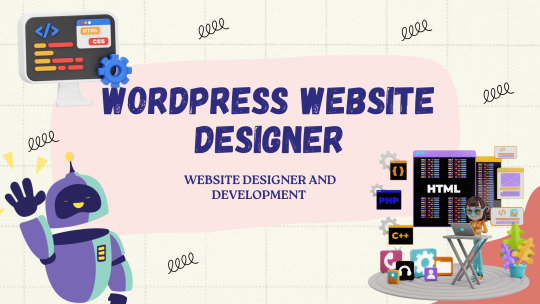#responsive shopify themes
Explore tagged Tumblr posts
Text
Boost Your Online Store's Performance with a Responsive Shopify Theme from Whiley Mai
Enhance your eCommerce experience with a responsive Shopify theme by Whiley Mai. Designed to adapt seamlessly across all devices, our themes ensure that your online store looks stunning and performs optimally on desktops, tablets, and smartphones. Whether you're aiming to attract more customers or improve user engagement, our responsive themes offer the flexibility and functionality needed to elevate your Shopify store. Explore our collection today and take your online presence to the next level!
0 notes
Photo

New Post has been published on https://themesnulled.us/topbike-v1-0-bike-store-responsive-shopify-theme-2/
TopBike v1.0 - Bike Store Responsive Shopify Theme
0 notes
Text
How to Choose the Best Shopify Website Design Company for Your Store in 2025?

In the ever-evolving world of eCommerce, having a well-designed and fully optimized Shopify store is no longer just an option – it's a necessity. As more consumers turn to online shopping, brands must ensure their Shopify website delivers an exceptional user experience, reflects the brand's identity, and supports seamless transactions. This is where a professional Shopify website design company can make all the difference.
Cross Atlantic Software, we understand that the decision to hire a Shopify website design company is a major step in your eCommerce journey. With so many service providers available, making the right choice can be overwhelming. This article aims to guide you through the most important factors to consider when selecting the right partner for your Shopify website design in 2025.
1. Understand Your Goals and Business Needs
Before you even begin searching for a Shopify website design company, clearly outline what you want your Shopify store to achieve. Are you launching a new brand, rebranding an existing one, or scaling up operations? Do you need custom integrations, advanced product filtering, or mobile-first Shopify design?
Having a clear vision will help you communicate effectively with potential design partners and ensure they align with your goals.
2. Look for Specialized Shopify Expertise
Not all web design companies specialize in Shopify. It's essential to choose a team that lives and breathes Shopify website design. Shopify has its own ecosystem, with unique themes, apps, and a proprietary Liquid coding language. Hiring a company that focuses specifically on Shopify design ensures they understand the platform inside-out.
Cross Atlantic Software has dedicated Shopify experts who have built and optimized hundreds of Shopify stores, giving clients the edge they need to compete in saturated markets.
3. Review Their Portfolio and Past Work
A reputable Shopify website design company should have a robust portfolio showcasing their past work. Look for:
Aesthetically pleasing, modern designs
Fast-loading Shopify websites
Mobile responsiveness
Seamless checkout experiences
Custom features like animations or personalized recommendations
Pay attention to diversity in their projects. This tells you whether the company can adapt their Shopify design to different industries and audiences.
4. Read Client Reviews and Testimonials
Real feedback from past clients is one of the most reliable ways to evaluate a Shopify website design company. Look beyond just the star ratings. Focus on detailed testimonials that highlight communication, professionalism, turnaround time, and post-launch support.
Cross Atlantic Software, we don’t just deliver projects — we build partnerships that grow with your business. Many of our clients have been with us for years, and we’re proud to be part of their ongoing success stories. Our testimonials reflect our commitment to excellence and custom-tailored Shopify website design solutions.
5. Ask About the Design and Development Process
Transparency is crucial. A reliable Shopify website design company should be able to walk you through their process from start to finish:
Initial Consultation
Strategy & Planning
Wireframing & Prototyping
Shopify Theme Customization or Custom Build
QA Testing & Optimization
Launch & Post-Launch Support
Knowing how your design team works isn’t just helpful — it’s essential. When everyone’s on the same page from day one, the process becomes smoother, timelines are clearer, and there are no last-minute surprises.
6. Consider Their Understanding of UX and Conversion Optimization
Good design isn't just about looking pretty. A successful Shopify website should convert visitors into buyers. That requires deep knowledge of user behavior, sales funnels, and design psychology.
Choose a Shopify website design company that prioritizes:
Clear CTAs (Call to Action)
Simple navigation
Fast page load times
Engaging product pages
Mobile-first design
Cross Atlantic Software, our team fuses creative Shopify design with data-backed UX principles to help you maximize conversions and sales.
7. Evaluate Support and Maintenance Services
Your Shopify store needs continuous updates, improvements, and sometimes emergency fixes. Make sure your design partner offers ongoing support even after launch. Ask questions like:
Do they offer monthly maintenance packages?
How do they handle bugs or errors?
Will you have a go-to person to call when something breaks or when you need a quick update? A dedicated point of contact makes all the difference when time and clarity matter most.
Cross Atlantic Software offers flexible support plans to ensure your Shopify website stays up-to-date, secure, and optimized at all times.
8. Transparency in Pricing
Clear pricing is a mark of a trustworthy Shopify website design company. While it's tempting to go with the lowest quote, remember that quality design and development require expertise and time.
Request a detailed breakdown of costs, including design, development, apps, and post-launch services. A good partner will explain every line item and adjust to fit your budget where possible.
9. Look for Creative Collaboration, Not Just Execution
The best outcomes happen when the design company works with you as a creative partner rather than just following orders. You should feel heard, respected, and inspired during the design journey.
Cross Atlantic Software, we treat every client as a collaborator. Our team engages in regular brainstorming sessions and strategy calls to ensure your vision translates beautifully into a high-performing Shopify store.
10. Check If They Offer Additional Services
Many eCommerce businesses need more than just Shopify website design. Check if your prospective partner can also help with:
SEO Optimization
Email Marketing Integration
App Integrations
Product Photography
Social Media Integration
A company that offers a comprehensive solution can save you time, money, and the hassle of managing multiple vendors.
Cross Atlantic Software provides end-to-end services to make your Shopify store launch as seamless and impactful as possible.
Conslusion:
Choosing the best Shopify website design company in 2025 is about more than just good looks. It requires strategic thinking, technical expertise, and a collaborative approach.
With a trusted partner like Cross Atlantic Software, you can build a Shopify website that not only looks amazing but also drives growth and customer loyalty.
Whether you're just starting out or looking to level up your current Shopify design, now is the time to make the investment in a company that understands your vision and has the skills to make it real.
Let’s simplify your eCommerce success — one pixel at a time.
Ready to build your dream Shopify store?
Visit us at www.crossatlantic.software and let’s get started.
4 notes
·
View notes
Text
What is a Website? A Complete Beginner’s Guide

In today’s digital age, having an online presence is not a luxury — it’s a necessity. Whether you're a business owner, content creator, or just someone curious about the web, understanding what a website is and how it functions is essential. In this guide, we’ll cover everything you need to know about websites, their components, types, benefits, and how to create one.
What is a Website?
A website is a collection of publicly accessible web pages that are linked together and share a single domain name. These pages are hosted on a web server and can include text, images, videos, forms, and other elements that users interact with online.
In simpler terms, a website is your virtual space on the internet — like your home or office in the digital world. It allows you to communicate, sell, educate, entertain, or showcase anything to a global audience.
Why is a Website Important Today?
In a world dominated by smartphones, search engines, and social media, a website acts as your central hub online. Here's why it’s important:
Visibility: A website helps you appear in search results when people look for your products, services, or information.
Credibility: A professional-looking site builds trust among your audience.
Accessibility: Your website is available 24/7, allowing customers to reach you anytime.
Marketing: It's the foundation for all your digital marketing efforts.
Sales: With e-commerce, your website can directly generate revenue.
Core Components of a Website
Every website has several key components that make it function properly:
1. Domain Name
This is your site’s address (e.g., www.digitalcreator.org.in). It’s what users type in their browser to visit your site.
2. Hosting Server
Web hosting stores your website’s data and serves it to users when requested.
3. Content Management System (CMS)
A CMS like WordPress, Joomla, or Shopify makes it easy to build and manage content on your website without coding.
4. Web Pages
These include the homepage, about us, contact, services, blog, etc., that make up your website.
5. Navigation
Menus and internal links guide visitors through your website.
Types of Websites
Different websites serve different purposes. Here are some common types:
1. Business Website
Used by companies to promote services, share information, and connect with clients.
2. E-commerce Website
Allows users to buy and sell products online. Examples include Amazon and Flipkart.
3. Portfolio Website
Ideal for creative professionals to showcase their work.
4. Blog or Personal Website
Used by individuals to share ideas, stories, or niche content regularly.
5. Educational Website
Used by schools, institutions, or educators to provide learning materials.
6. Non-profit or Government Website
Focused on delivering information and services to the public.
How to Create a Website (Step-by-Step)
Creating a website doesn’t require you to be a tech expert. Follow these steps:
Step 1: Choose a Domain Name
Pick a short, relevant, and memorable domain name. Make sure it reflects your brand or purpose.
Step 2: Get Web Hosting
Choose a reliable hosting provider like Bluehost, SiteGround, or Hostinger.
Step 3: Select a CMS or Website Builder
Use platforms like WordPress, Wix, or Shopify to start building your website.
Step 4: Design Your Website
Choose a theme or template. Customize colors, fonts, and layout to match your brand.
Step 5: Add Content
Create and publish pages like Home, About, Services, and Contact. Use quality visuals and optimized text.
Step 6: Optimize for SEO
Use keywords (like website) naturally, optimize images, and ensure fast load speed.
Step 7: Launch and Promote
Once satisfied, make your website live. Share it on social media and start your SEO or ad campaigns.
Best Practices for a Great Website
Responsive Design: Ensure your site works well on all devices.
Fast Loading Speed: Use compressed images and optimized code.
Clear Navigation: Make it easy for users to find what they need.
Secure (HTTPS): Use an SSL certificate to protect data.
Call-to-Action (CTA): Guide visitors toward actions like “Buy Now” or “Contact Us.”
Examples of Great Websites
A well-designed and fully functional example is www.digitalcreator.org.in. It demonstrates how a website can showcase services, build trust, and attract new clients efficiently.
LSI Keywords to Keep in Mind
While writing or optimizing your website, include these Latent Semantic Indexing (LSI) keywords to enhance search performance:
Web design
Online presence
Website development
Internet site
Web page
Digital platform
Domain and hosting
CMS (Content Management System)
Website builder
E-commerce site
Frequently Asked Questions (FAQs)
1. What is the purpose of a website?
A website helps individuals or businesses share information, sell products, provide services, or connect with others online.
2. How much does it cost to build a website?
Costs vary based on design, features, and hosting. Basic websites can cost as low as ₹3,000–₹10,000, while advanced ones may go up to ₹1 lakh or more.
3. Do I need coding skills to create a website?
No. Tools like WordPress or Wix allow you to build a full website without writing any code.
4. How long does it take to build a website?
A simple website can be built in 1–2 days. More complex sites may take a few weeks.
5. What makes a website successful?
A successful website is user-friendly, fast, mobile-optimized, secure, and offers valuable content with clear calls-to-action.
Conclusion
Understanding what a website is is the first step toward establishing your digital footprint. Whether you're planning to launch a personal blog, online store, or professional portfolio, your website will serve as the foundation of your online presence.
If you're ready to build or improve your website, visit www.digitalcreator.org.in — your one-stop destination for digital marketing and website development solutions.
2 notes
·
View notes
Text
The Ultimate Guide to Growing Your Shopify Store in 2025
Running a Shopify store in 2025 is more competitive than ever, but with the right strategies, you can stand out and build a thriving eCommerce business. Whether you're just starting or looking to scale, here’s a complete guide to optimizing your Shopify store for success.
1. Perfect Your Store’s Design & User Experience
Your store’s design plays a huge role in conversions. Here’s how to make it visually appealing and user-friendly:
✔ Choose a Clean, Mobile-Optimized Theme – 70%+ of online shopping happens on mobile devices, so a responsive theme is a must.
✔ Simplify Navigation – Make it easy for visitors to find what they need with clear menus and search functionality.
✔ Use High-Quality Images & Videos – Professional product photography builds trust and increases conversions.
✔ Speed Up Your Site – Slow-loading pages lead to lost sales. Use compressed images and Shopify speed optimization apps.
2. SEO: Get Found on Google
Search Engine Optimization (SEO) helps your store rank higher on Google, bringing in free organic traffic.
✔ Keyword Optimization – Use relevant keywords in product titles, descriptions, and blog posts.
✔ Meta Descriptions & Alt Text – Write compelling meta descriptions and add alt text to images for better indexing.
✔ Content Marketing – Start a blog to share product guides, tips, and industry insights.
3. Use Email Marketing & Automation
Email marketing is still one of the most effective ways to drive sales. Here’s how to make it work for your Shopify store:
✔ Set Up Abandoned Cart Emails – Recover lost sales with automated reminders.
✔ Welcome Sequences – Engage new subscribers with exclusive discounts and brand stories.
✔ Segmentation & Personalization – Send tailored product recommendations based on customer preferences.
4. Leverage Social Media & Paid Ads
Social media can drive massive traffic and sales when used correctly.
✔ Instagram & TikTok Shopping – Link your Shopify store directly to these platforms for seamless shopping.
✔ Facebook & Google Ads – Run retargeting ads to bring back visitors who didn’t purchase.
✔ Influencer Marketing – Partner with influencers in your niche for increased credibility and reach.
5. Optimize for Conversions
Driving traffic is great, but converting visitors into customers is the real game-changer.
✔ Offer Discounts & Free Shipping – Create urgency with time-limited offers.
✔ Use Trust Badges & Reviews – Social proof increases customer confidence.
✔ Simplify Checkout – A one-page checkout process reduces cart abandonment.
6. Upselling & Cross-Selling Strategies
Maximize each sale by offering related products or premium versions.
✔ Bundle Deals – Encourage customers to buy more with discounted product bundles.
✔ Post-Purchase Upsells – Suggest add-ons after checkout for an easy extra sale.
7. Leverage Shopify Apps
Shopify’s app ecosystem allows you to add powerful features to your store. Some must-have apps include:
✔ Klaviyo – For advanced email marketing automation.
✔ ReConvert – For upselling and post-purchase funnels.
✔ PageFly – To design custom landing pages that convert.
Final Thoughts
Success in Shopify isn’t just about launching a store—it’s about continuously optimizing, learning, and evolving. By focusing on design, SEO, marketing, and conversions, you’ll be on your way to building a profitable online store.
Want expert help setting up or scaling your Shopify store? As a Shopify expert, I offer professional store design, SEO, and marketing services. Feel free to reach out and let’s take your store to the next level!
4 notes
·
View notes
Text
Best Web Design and Hosting for Small Business
User experience (UX) is a top priority for a successful small company website. This features responsive layouts that guarantee smooth surfing across devices, clear information hierarchy, and easy navigation. Websites should captivate users with eye-catching graphics, excellent photos, and interactive features that are consistent with the brand's identity. For small businesses looking to establish a strong online presence, investing in quality web design and reliable hosting is paramount.
Creating a powerful brand identity is essential. In order to create a unified image that makes an impression on visitors, this entails using logos, colors, and font consistently throughout the website. Retaining user interest also requires interesting material that speaks to the demands of the target audience, including educational blog entries and captivating product descriptions.
How to Make a Website for a Small Business
Select a User-Friendly Website Builder: Website construction is made easier by the intuitive interfaces of platforms like as Squarespace, Shopify, and Wix. Because these builders frequently have drag-and-drop capabilities, consumers can alter their websites without knowing any code23.
Choose a Domain Name and Register It
A memorable domain name is crucial for internet branding and represents your company's identity. Make sure it is pertinent to your services and simple to spell.
Select a Trustworthy Web Hosting Provider
The performance of the website depends on the hosting provider selection. Important things to think about are:
Uptime Promise: To reduce downtime, look for hosts that have 99.9% uptime.
Loading Speed: To improve user experience, try to keep page load times under three seconds.
Features of Security: To safeguard your site2, be sure the server offers SSL certificates, frequent backups, and virus detection.
Customer service: For prompt problem solving, round-the-clock assistance can be essential.
Create the Visual Identity for Your Website
Make an eye-catching layout that complements the style of your brand. Make use of top-notch photos and keep design components consistent.
Plan the Navigation and Site Structure
Logically arrange your information to make it easier to navigate. A site with a clear structure makes it easier for people to find information fast.
Create Key Pages
Home, About Us, Services/Products, Blog, and Contact Us are all important pages. Every page should contribute to the general objectives of the website while fulfilling a distinct function.
Top Web Design Platforms for Small Businesses
WordPress:
Flexible and customizable with thousands of plugins and themes.
Ideal for businesses looking for scalability and SEO features.
Wix:
Drag-and-drop functionality for easy website creation.
Suitable for businesses without technical expertise.
Squarespace:
Modern templates and built-in e-commerce features.
Perfect for visually appealing designs.
Shopify:
Best for small businesses focused on e-commerce.
Features include inventory management, payment integration, and analytics.
Weebly:
Affordable and user-friendly.
Ideal for small businesses needing basic functionality.

#Best Web Design and Hosting for Small Business#website#website design#seo services#digital marketing#web design#web development#usa news#usa
3 notes
·
View notes
Text
Choosing the Right Shopify Theme for Your Online Store: A Complete Guide

Selecting the right theme is crucial to the success of your Shopify store. It sets the tone for your brand, influences user experience, and plays a vital role in converting visitors into customers.
Why Shopify Themes Matter
Shopify offers an extensive marketplace of themes, both free and paid. Each theme comes with its unique layout, customization options, and features. The theme you select dictates the overall look and feel of your store. A well-designed theme can:
Boost Engagement: Visual appeal is one of the first things customers notice. A clean, intuitive design keeps visitors on your site longer, reducing bounce rates.
Enhance User Experience: A theme that’s easy to navigate makes the shopping process smoother for customers, improving overall satisfaction.
Increase Conversions: With optimized layouts and responsive designs, the right theme can lead to higher sales.
Improve SEO Performance: A theme optimized for mobile devices, fast loading times, and clear navigation structures will positively impact your store’s search engine rankings.
Features to Look for in a Shopify Theme

When choosing a theme, it’s essential to look beyond the aesthetic. Here are some key features to consider:
1. Responsive Design
Your customers may be shopping from a variety of devices, from desktop computers to smartphones. A responsive design ensures that your store looks great and functions seamlessly across all devices. This is also a crucial factor for SEO, as Google prioritizes mobile-friendly websites in its search results.
2. Customizability
No two stores are the same, and neither should their themes be. Look for themes that offer extensive customization options. This allows you to tailor the design, colors, fonts, and layout to align with your brand.
3. Fast Loading Time
Site speed is critical for user experience and SEO. A slow-loading site frustrates visitors and drives them away. Make sure the theme you choose is optimized for performance to keep users engaged and improve conversion rates.
4. Integration with Apps
Your Shopify store likely uses various apps to enhance functionality. From marketing automation to customer support tools, a good theme should integrate smoothly with Shopify’s vast ecosystem of apps, providing a cohesive experience.
5. Support and Updates
Themes should be regularly updated to keep up with platform changes and security improvements. Ensure that your theme developer provides ongoing support and updates, so your store remains functional and secure.
6. SEO Optimization
Many Shopify themes come with built-in SEO features, including clean HTML coding, fast page load times, and mobile-friendliness. These features are vital for improving your store’s visibility on search engines.
Free vs. Paid Shopify Themes
One major decision when choosing a theme is whether to go for a free or paid option. Here’s a quick comparison:
Free Themes: Shopify’s free themes are simple, clean, and functional. They’re great for beginners or those on a budget. However, they usually offer limited customization and features.
Paid Themes: Premium themes come with more advanced features, extensive customization options, and higher-quality design. They are typically more optimized for performance and SEO. The investment in a paid theme can significantly impact your store's success by providing a polished, professional appearance and better user experience.
How to Choose the Right Shopify Theme for Your Business
Choosing a theme can be overwhelming with so many options available. Here’s a step-by-step guide to help you narrow down the right one for your business:
Understand Your Niche: Your store's theme should reflect your niche. For example, a minimalist theme works well for a luxury fashion store, while a vibrant and playful theme might suit a kids' toy store.
Consider Your Branding: Make sure the theme aligns with your brand colors, fonts, and messaging.
Check Reviews: Always read reviews before purchasing a theme. Look for feedback on the theme’s performance, ease of customization, and support.
Preview the Theme: Most Shopify themes allow you to preview your store’s design before committing. This helps you get a real-time feel of how the theme would look with your products.
Test Responsiveness: Check how the theme appears across different devices to ensure a seamless shopping experience for your customers.
Introducing Impression - Premium Shopify Theme by Arham Web Works
If you’re looking for the perfect Shopify theme, look no further than Impression - Premium Shopify Theme by Arham Web Works. This theme is designed to help your e-commerce store stand out and provide a top-tier shopping experience for your customers.
Key Features of Impression:
Fully Responsive Design: No matter where your customers are shopping from—whether it’s a desktop, tablet, or smartphone—the "Impression" theme ensures a flawless experience across all devices. This leads to better user engagement and satisfaction.
Customizable Layouts: With a range of layout options, you can tailor the look and feel of your store to match your brand. Choose from various pre-designed templates or create your own to match your unique vision.
Performance-Optimized: "Impression" is designed to be fast and lightweight, ensuring that your store loads quickly. This enhances customer experience and helps with search engine rankings.
Boost Conversions: With "Impression," you can expect up to a 20% increase in conversions, thanks to its intuitive design and customer-focused features.
Easy Integration: The theme works seamlessly with Shopify’s app ecosystem, so you can enhance your store’s functionality without any technical headaches.
Choosing the right Shopify theme is essential for the success of your online store. With the Impression - Premium Shopify Theme by Arham Web Works, you get a beautiful, functional, and conversion-optimized design that will take your e-commerce business to the next level.
2 notes
·
View notes
Text
Improve the Success of your Online Store with Reblate Solutions
Reblate Solutions partners with Shopify to provide top-notch e-commerce solutions that help businesses thrive online. Shopify's powerful platform combined with our expertise ensures that your online storeis optimized for success.
Here's how we can assist you with Shopify:
Shopify Store Setup and Customization
Starting an online store can be overwhelming, but Reblate Solutions makes it easy. We handle everything from setting up your Shopify store to customizing it to reflect your brand identity. Our design and development team creates visually appealing, user-friendly stores that enhance the shopping experience.
Theme Development and Customization
Choose from a wide range of Shopify themes or let us create a custom theme tailored to your business. Our developers ensure that your theme is not only aesthetically pleasing but also responsive and optimized for performance on all devices.
Product Management
Efficient product management is crucial for a successful e-commerce store. We assist with product listings, categorization, pricing, and inventory management. Our team ensures that your products are presented in the best possible way to attract and convert customers.
Shopify SEO
Improve your store’s visibility with our Shopify SEO services. We optimize product pages, implement effective keyword strategies, and ensure that your store is search-engine friendly. Our goal is to drive organic traffic to your store and increase your search rankings.
Payment Gateway Integration
We integrate secure and reliable payment gateways into your Shopify store, providing your customers with multiple payment options. From credit cards to digital wallets, we ensure a seamless and secure checkout process.
Shopify App Integration
Enhance the functionality of your Shopify store with the right apps. We help you select and integrate apps that streamline operations, improve customer experience, and boost sales. Whether it’s marketing tools, inventory management, or customer service apps, we’ve got you covered.
Shopify Marketing and Advertising
Boost your store’s reach with targeted marketing campaigns. We create and manage social media ads, Google Ads, and email marketing campaigns to attract and retain customers. Our data-driven approach ensures that your marketing budget is spent effectively.
Analytics and Reporting
Understand your store’s performance with our comprehensive analytics and reporting services. We provide insights into customer behavior, sales trends, and marketing effectiveness. Our reports help you make informed decisions to grow your business.
Customer Support
Provide exceptional customer service with our support solutions. We set up and manage customer service channels, ensuring that inquiries and issues are addressed promptly. Our focus is on building trust and maintaining customer satisfaction.
Shopify Compliance and Security
Ensure your store complies with industry standards and Shopify’s policies. We implement best practices for data security, privacy, and regulatory compliance, giving you peace of mind.
By leveraging the power of Shopify and the expertise of Reblate Solutions, your e-commerce business can achieve new heights. We provide tailored solutions that meet your unique needs, helping you build a successful online store that stands out in the competitive e-commerce landscape.
#e commerce sites#ecommerce website development#free shopping cart#ecommerce solutions#shopify store#Shopify Development#Shopify#Shopify Apps#reblate solutions
3 notes
·
View notes
Text
Shopify Development Agency That Offers Client-Centric Ecommerce Solutions

With nearly one-third of the eCommerce market to its credit, the Shopify platform offers easy-to-customize themes, scalable architecture, secure payment gateways, easy setup, responsive design, SEO features, and more to build the best online store possible. Rely on our shopify development agency when you want a solid team of Shopify developers who convert product shopping into a fantastic user experience.
4 notes
·
View notes
Text
I will work on wordpress website design and development
Thanks for stopping at my online shop
I serve my expertise your business effective worldwide Internet exposure at low prices. professional and modern WordPress Website Designer. I complete all my project with absolute devotion and perfection. I customize Responsive WordPress Website regularly and can help customize yours, so you can get your site up and running.
So here are the services you will get from me:
After Sales Service
Speed Optimization
Professional themes
E-Commerce Setup
Secure Admin Panel
Forms & package creator
Shopify Stores
Backup Files
Secure content
Repair, redesign and fixing of existing sites
Note : If you have any questions watch contact me now.
ORDER NOW : https://www.fiverr.com/s/o3b5lb

#fiverr#fiver gig#freelancing#upwork#gig work#wordpress#wordpress website#wordpress web design#wordpress development#wordpress themes#wordpress plugins#website#webdesign#webdevelopment#web developing company#web developers
3 notes
·
View notes
Text
I will design, redesign shopify store, shopify dropshipping store, shopify website

Are you looking for a Shopify expert to create a highly profitable Shopify dropshipping store that generates Good revenue?
Look No Further, I will help you
As a Shopify expert with a track record of building successful online businesses, I will assist you in making your dreams a reality.
I am a professional Shopify designer with years of experience. I specialize in design redesign, custom, responsive, visually stunning, high-converting Shopify dropshipping stores / websites that are tailored to your specific business needs and generate significant revenue.
What I Will Provide:
Shopify Store Build and Customization With Premium Theme
Shopify Website Development
SEO Optimization
Responsive Design
App Integration
Payment Gateway Setup
Live Chat Integration
Why Should You Hire Me:
Visually appealing and user-friendly Shopify store design that reflects your brand and engages your audience.
Custom Shopify development to meet your specific needs, from integrating third-party apps to building custom plugins.
Be smart and make smart decisions! Place an order today and enjoy premium services.
Check it out here
#shopify#shopify store#shopify website#shopify dropshipping#dropshipping#shopify store design#shopify store design and redesign#shopify one product store design#shopify store setup#setup shopify dropshipping store#setup shopify store#shopify store creation#copy shopify store#shopify store development#print on demand shopify store#jewelry shopify store
2 notes
·
View notes
Text
Ten Steps Into The Development Of An E-Commerce

In the digital age, establishing an online presence through an e-commerce website is crucial for businesses to expand their reach and increase sales. The process of e-commerce site development requires careful planning, execution, and optimization to ensure a seamless and engaging shopping experience for customers. In this guide, we'll outline ten essential steps in the development of an e-commerce website, incorporating key strategies and leveraging advanced solutions like Xettle Technologies for enhanced functionality.
Step 1: Define Your Goals and Objectives
Before embarking on e-commerce site development, clearly define your business goals and objectives. Determine your target audience, product offerings, revenue targets, and desired features for the website. This foundational step will guide the entire development process and ensure alignment with your business objectives.
Step 2: Choose the Right E-commerce Platform
Selecting the right e-commerce platform is crucial for the success of your online store. Consider factors such as scalability, customization options, security features, and ease of use. Platforms like WooCommerce, Shopify, Magento, and BigCommerce offer robust solutions for e-commerce site development, catering to different business needs and budgets.
Step 3: Design a User-Friendly Interface
Design a visually appealing and user-friendly interface for your e-commerce website. Ensure intuitive navigation, clear product categorization, and seamless checkout process to enhance the user experience. Leverage responsive design principles to optimize your website for mobile devices and ensure accessibility across all screen sizes.
Step 4: Develop and Customize Your Website
Customize your e-commerce website to reflect your brand identity and meet the specific needs of your business. Choose a theme or template that aligns with your brand aesthetic and customize it with your logo, color scheme, and branding elements. Implement features such as product filters, search functionality, and customer reviews to enhance usability.
Step 5: Integrate Secure Payment Gateways
Integrate secure payment gateways to facilitate smooth and secure transactions on your e-commerce website. Offer a variety of payment options to cater to customer preferences, including credit/debit cards, digital wallets, and alternative payment methods. Ensure compliance with PCI DSS standards to protect sensitive customer information.
Step 6: Optimize for Search Engines
Implement search engine optimization (SEO) strategies to improve the visibility and ranking of your e-commerce website in search engine results. Optimize product descriptions, meta titles, and URLs with relevant keywords. Create high-quality content, optimize images, and build backlinks to attract organic traffic to your site.
Step 7: Implement Analytics and Tracking
Integrate analytics tools such as Google Analytics into your e-commerce website to track visitor behavior, monitor performance metrics, and gain insights into customer preferences. Analyze data on sales, traffic sources, conversion rates, and user engagement to make informed decisions and optimize your marketing strategies.
Step 8: Ensure Website Security
Prioritize website security to protect customer data and build trust with your audience. Implement SSL encryption, secure hosting, and regular security audits to safeguard against cyber threats and data breaches. Partner with reputable security providers and adhere to industry standards to maintain the integrity of your e-commerce website.
Step 9: Test and Iterate
Conduct thorough testing of your e-commerce website across different devices, browsers, and operating systems to identify and resolve any issues or bugs. Test functionality, performance, and usability to ensure a seamless shopping experience for users. Continuously gather feedback from customers and iterate based on their preferences and suggestions.
Step 10: Leverage Advanced Solutions like Xettle Technologies
Incorporate advanced solutions like Xettle Technologies to enhance the functionality and performance of your e-commerce website. Xettle offers AI-driven financial insights, predictive analytics, and personalized recommendations to optimize decision-making, improve customer engagement, and drive sales. By leveraging Xettle Technologies, you can stay ahead of the competition and deliver a superior shopping experience to your customers.
Conclusion
Building an e-commerce website requires careful planning, execution, and optimization to succeed in the competitive online marketplace. By following the ten essential steps outlined in this guide and leveraging advanced solutions like Xettle Technologies, you can create a feature-rich and user-friendly e-commerce website that attracts customers, drives sales, and fosters long-term success for your business. With continuous monitoring, optimization, and innovation, your e-commerce site will evolve to meet the changing needs and expectations of your audience, ensuring sustained growth and profitability in the digital era.
2 notes
·
View notes
Photo

New Post has been published on https://themesnulled.us/topbike-v1-0-bike-store-responsive-shopify-theme/
TopBike v1.0 - Bike Store Responsive Shopify Theme
0 notes
Text
How to Turn Your Online Business Dreams into Reality


Introduction: The Digital Frontier of Entrepreneurship Selecting a Niche and Business Model: The Foundation of Success Building Your Online Platform and Brand: Your Digital Headquarters Creating High-Demand Products and Services: Delivering Value to Your Audience Implementing Effective Marketing Strategies: Attracting Targeted Traffic Diversifying Revenue Streams for Maximum Profits: Building Financial Stability Optimizing for Maximum Profitability Long-Term: Building a Sustainable Business Conclusion: Turning Dreams into Reality True successful story
Introduction: The Digital Frontier of Entrepreneurship
In today's digital age, the rise of the internet and technology has revolutionized the way we do business. It has opened a world of opportunities for entrepreneurs to start and run their own businesses online. Online businesses offer flexibility, scalability, and the potential for global reach. This comprehensive guide will provide you with a step-by-step framework for building a profitable online business from the ground up. Whether you want to start a side business or build a full-time online empire, follow this ultimate guide to turn your idea into a thriving, sustainable online business. With focus, grit, and commitment to continuous improvement, you can build the profitable online business of your dreams.
Selecting a Niche and Business Model: The Foundation of Success
The foundation of every successful online business is choosing a profitable, in-demand niche and a business model tailored to your goals. Select a niche you're passionate about; this will make creating content a breeze. Conduct thorough keyword research to assess search volume and demand. Join relevant online communities to connect with your audience and understand their needs. Evaluate direct competitors in the niche and aim for less saturated niches or unique angles. Consider affiliate marketing potential, as some niches offer higher commissions. Assess opportunities to create multiple products and monetize in diverse ways. Examples of popular online business niches include health, fitness, personal finance, pet care, tech, travel, content marketing, home design, spirituality, language learning, and more. Choose a business model that complements your niche and provides multiple income stream opportunities. Many successful online businesses incorporate 3-4 monetization models. Some of the best online business models to consider include: 1. Blogging: Make money with display ads, affiliates, and branded products. 2. Online Courses: Sell your knowledge and expertise as courses. 3. Dropshipping: Curate and sell products without inventory. 4. Affiliate Marketing: Earn commissions promoting other companies' products. 5. Information Products: Sell online books, templates, checklists, and more. 6. Virtual Services: Provide consulting, freelancing, coaching, or other services. 7. Subscription Membership Site: Offer exclusive content or tools for a monthly fee. 8. E-commerce Store: Sell physical products, merchandising, and more. Your choice should complement your niche and offer multiple income streams. Many successful online businesses incorporate 3-4 monetization models.
Building Your Online Platform and Brand: Your Digital Headquarters
Your website or blog will serve as the headquarters for your online business. Invest time upfront in creating an optimized, professional-looking platform. Purchase a domain name that matches your brand, ideally a .com if available. Select reliable web hosting with optimal speed and uptime. Install WordPress or ecommerce platforms like Shopify or WooCommerce. Design an on-brand, mobile-responsive theme that conveys your style. Include essential pages like Home, About, Contact, Services, Blog, and Shop. Set up email marketing and analytics to capture leads and track traffic data. Create visually branded assets such as logos, color palettes, fonts, and graphics. Ensure a cohesive user experience across all touchpoints. If you lack web development skills, consider hiring a freelance designer to bring your vision to life. Continually optimize your website for higher traffic, leads, and sales over time. This includes technical enhancements, user experience improvements, and page speed optimizations.
Creating High-Demand Products and Services: Delivering Value to Your Audience
The key to running a profitable online business is consistently creating products and services that deliver extreme value to your audience. Popular digital products you can create include online courses, eBooks, guides, checklists, software, premium memberships, virtual events, video tutorials, templates, and more. When brainstorming products, look for opportunities to simplify lives, save time, educate, entertain, or improve outcomes for your target customers. Leverage your expertise and tap into the skills of others to create premium offerings. High-value services like consulting, freelancing, coaching, and more can also be extremely lucrative. Promote your services through your website and social platforms. Structure your offerings to passively earn income over time, such as online courses that continually generate sales vs. 1-on-1 services that require ongoing effort. Deliver an excellent user experience across your products and relentlessly optimize based on feedback to foster raving fans who refer others.

Implementing Effective Marketing Strategies: Attracting Targeted Traffic
Once your online platform and offerings are ready, it's time to start attracting targeted traffic using proven marketing tactics. A diverse marketing mix is key. Some of the top strategies include: 1. Content Marketing: Create engaging blog posts, videos, and visual content. 2. SEO: Optimize your website for search engines through on-page optimization and link-building. 3. PPC Ads: Utilize platforms like Google, Facebook, Instagram, and YouTube for pay-per-click advertising. 4. Email Marketing: Build your email list with lead magnets, newsletters, and automation. 5. Social Media Marketing: Employ organic and paid tactics to engage your audience. 6. Affiliate Marketing: Recruit others to promote your products and earn commissions. 7. Influencer Partnerships: Collaborate with relevant influencers in your niche. 8. Live Events: Host local meetups or virtual events to connect with your audience. 9. Podcast Guest Appearances: Grow your authority and reach new audiences. 10. Retargeting Ads: Remarket to previous site visitors across the web. Start by focusing on 1-3 core channels, then expand your efforts over time. Pay-per-click and social ads can help quickly scale an audience, while SEO and content creation tend to be most cost-effective in the long-term. Leverage tools like Google Analytics, Facebook Business Suite, and landing page builders to optimize results across all campaigns. Don't hesitate to enlist help from digital marketing agencies and specialists.
Diversifying Revenue Streams for Maximum Profits: Building Financial Stability
Generating multiple streams of revenue is key for building a highly profitable online business. Diversification reduces risk and provides stability as each income channel goes through ups and downs. Here are some of the most lucrative online business revenue models: 1. Product/Service Sales: Your core monetization stream. Ensure competitive yet profitable pricing. 2. Advertising: Display ads, sponsorships, native advertising, etc. Set up Google Ad Manager. 3. Affiliate Marketing: Promote other company's products for commissions. Join affiliate networks. 4. Memberships/Subscriptions: Offer exclusive benefits, content, or tools for a monthly fee. 5. Events: Sell tickets for online or in-person events and training programs. 6. Dropshipping: Curate and sell products without holding inventory. 7. Physical Merchandise: Sell branded products with print-on-demand services. 8. Consulting/Freelancing: Sell your skills and expertise through 1-on-1 services. 9. Tip Jars/Donations: Allow fans to tip or donate to show support. Aim to generate income from both active efforts like service packages and passive streams like online courses that earn as you sleep. Automate processes wherever possible to scale income without increasing workload proportionally. Reinvest profits back into growing your business and diversifying income channels to create an unstoppable snowball effect over time.



Optimizing for Maximum Profitability Long-Term: Building a Sustainable Business
Launching a profitable online business is an important first step. However, creating systems and processes that enable high profitability long-term is vital for sustaining growth. Here are some best practices for optimizing operations and profitability: - Obsessively track KPIs and metrics for all marketing channels and funnels. Analyze data to optimize underperforming areas. - Create excellent customer support systems. Provide prompt, personalized support to increase satisfaction and referrals. - Automate repetitive tasks wherever possible with tools like Zapier. Automate lead collection, customer onboarding, analytics, inventory management, etc. - Systematize your product creation process to quickly test and validate new product ideas, then scale those that resonate. - Document your systems and processes so future hires can replicate them. This includes SOPs for customer service, product fulfillment, etc. - Build a skilled team over time by hiring virtual assistants, freelancers, agencies, and eventually full-time employees. Focus on higher-level strategy. - Maintain work-life balance as a long-term entrepreneur. Make time for adequate rest, leisure, and self-care to avoid burnout. By staying agile, embracing innovation, and relentlessly providing value to your audience, you can build an online business that delivers meaningful income for decades to come.



Conclusion: Turning Dreams into Reality
Starting and running a profitable online business takes consistent effort and persistence. However, by zeroing in on a niche, selecting the right model, crafting high-value offerings, implementing diverse marketing strategies, diversifying your revenue streams, and optimizing for maximum efficiency, you can build an online business that provides freedom and fulfillment for years to come. Remember to stay obsessively focused on understanding and serving your target audience. Combine your passion with grit, resilience, and creativity. With the right mindset and business foundations in place, you have immense potential to build a thriving online business that stands out and makes a lasting impact. The time to stop dreaming and start taking action is now. Follow this comprehensive guide to turn your online business idea into reality, step-by-step. You can build an online empire that allows you to live life on your terms. The possibilities are truly endless if you commit to continuous learning and improvement. Let this guide spark the fire within and set you on the path to online business success. Start pursuing your online entrepreneur dream today.


True successful story
To illustrate the principles and strategies discussed in this comprehensive guide, let's delve into the inspiring true story of Pat Flynn and his online business, Smart Passive Income. Smart Passive Income - About Pat Flynn Background: Pat Flynn was once an aspiring architect who unexpectedly found himself laid off during the economic downturn in 2008. Faced with uncertainty, he turned to the online world to seek alternative income sources. His journey began with a blog, which he aptly named Smart Passive Income (SPI). Selecting a Niche and Business Model: Pat recognized that there was a significant demand for information about creating online businesses and generating passive income. He was passionate about sharing his experiences, both successes and failures, and helping others navigate the world of online entrepreneurship. Pat's chosen niche was personal finance, but his business model extended beyond blogging. Building Your Online Platform and Brand: Pat invested in creating a professional-looking platform for SPI. He purchased a domain name, set up reliable web hosting, and designed an appealing website. His commitment to providing value was evident through the content he produced on his blog, podcast, and YouTube channel. His brand, Smart Passive Income, became synonymous with transparency, authenticity, and actionable advice. Creating High-Demand Products and Services: One of Pat's significant successes came from his creation of online courses and informational products. He developed courses on topics like email marketing, affiliate marketing, and podcasting, leveraging his expertise and audience trust. These products delivered immense value to his audience and contributed significantly to his income. Implementing Effective Marketing Strategies: Pat's marketing strategy was built on content marketing, podcasting, and email marketing. He consistently produced high-quality blog posts and podcasts, which not only attracted a dedicated audience but also positioned him as an industry expert. His email list grew as he offered valuable lead magnets and nurtured his subscribers. Diversifying Revenue Streams for Maximum Profits: Pat's income streams diversified over time. In addition to course sales, he earned from affiliate marketing, book sales, and speaking engagements. He also ventured into software development, creating tools like the Smart Podcast Player. This diversification provided stability and mitigated risk. Optimizing for Maximum Profitability Long-Term: Pat was relentless in optimizing his operations. He regularly analyzed data and user feedback to improve his products and content. His team expanded as the business grew, allowing him to focus on strategic decision-making. Pat prioritized work-life balance, emphasizing family and well-being. Conclusion: Pat Flynn's journey from unexpected job loss to the creation of a successful online business, Smart Passive Income, serves as an inspiring real-life example of the principles discussed in this guide. His dedication to providing value, commitment to continuous improvement, and willingness to diversify income streams are key takeaways for anyone aspiring to build a thriving online business. Pat's story reminds us that with the right mindset and a clear vision, online entrepreneurship can lead to a fulfilling and prosperous career.


Read the full article
#business-model#guide#marketing#niche#online-business#products#profitability#revenue#services#Success
5 notes
·
View notes
Text
Crafting E-Commerce Excellence: The Power of Shopify Web Design
In the realm of e-commerce, a captivating online store can make all the difference. Shopify web design, a dynamic and robust platform, is the driving force behind many successful online businesses. This platform empowers businesses to create visually stunning, user-friendly, and highly functional e-commerce websites.
Shopify offers an array of customizable templates and themes that cater to various industries and aesthetics. This flexibility allows businesses to build a unique and engaging online presence that aligns perfectly with their brand identity.
Furthermore, Shopify simplifies the complexities of online retail. From inventory management and secure payment gateways to seamless checkout processes, it provides all the tools needed to run a successful online store. This ease of use ensures that business owners can focus on what they do best – selling products or services – rather than getting bogged down by technical intricacies.
Another remarkable feature of Shopify is its mobile responsiveness. With a growing number of consumers shopping via mobile devices, having a website that looks and functions flawlessly on smartphones and tablets is essential. Shopify ensures that your e-commerce website is ready to capture the mobile market.
Shopify also excels in search engine optimization (SEO) capabilities. It provides businesses with the tools and features needed to optimize their websites for search engines, helping them rank higher in search results and reach a broader audience.
In conclusion, Shopify web design is a game-changer in the world of e-commerce. It offers businesses the power to create visually stunning, user-friendly, and highly functional online stores that cater to the demands of the modern digital consumer. With its customizable templates, mobile responsiveness, and SEO capabilities, Shopify is the platform of choice for businesses looking to thrive in the competitive online marketplace.
2 notes
·
View notes
Text
Develop Your Online Store with the most satisfactory Shopify Design Expert
Introduction:
In today's rapidly evolving digital landscape, having a strong online presence is crucial for the success of any business. LassoART Design e-commerce, entrepreneurs, and businesses are working with platforms like Shopify to establish their online stores. However, to stand out in a sea of competitors, it's essential to have a visually appealing and user-friendly website that captivates your target audience. LassoART Design where a Shopify design expert can be a game-changer for your business.
Crafting a Unique Brand Identity:
A Shopify design expert understands the significance of creating a distinct brand identity that resonates with your target market. They will work closely with you to understand your brand values, target audience, and business goals. Through a combination of appealing visuals, intuitive navigation, and compelling content, they will create a unique and cohesive brand experience for your customers. A visually appealing website will not only capture the attention of potential customers but also build trust and credibility in your brand.
Tailored Theme Customization:
While Shopify offers a wide range of pre-designed themes, a Shopify design expert can take your online store to the next level by customizing the theme to align with your brand. They possess an in-depth understanding of Shopify's capabilities and can tailor the design elements, including color schemes, fonts, layouts, and imagery, to reflect your brand personality. This level of customization ensures that your website stands out from the crowd and provides a seamless user experience.
Optimized User Experience (UX):
User experience plays a pivotal role in determining the success of an e-commerce store. A Shopify design expert will focus on optimizing the user experience by streamlining the purchasing process, enhancing site performance, and ensuring easy navigation. By implementing user-friendly interfaces, intuitive menus, and clear calls to action, they make it effortless for your customers to find and purchase the products they desire. This leads to higher conversion rates, increased customer satisfaction, and improved customer retention.
Responsive and Mobile-First Design:
With the growing number of consumers accessing websites through mobile devices, having a responsive and mobile-friendly design is no longer an option—it's a necessity. A Shopify design expert will ensure that your website is fully optimized for mobile devices, providing a seamless browsing and shopping experience across various screen sizes. This mobile-first approach allows you to tap into the vast potential of mobile e-commerce and reach a wider audience.
Ongoing Support and Maintenance:
Building a successful e-commerce store is an ongoing process. A Shopify design expert will not only create an impressive website but also provide ongoing support and maintenance. They will monitor your website's performance, address any issues that arise, and implement necessary updates to keep your store running smoothly. This saves you valuable time and effort, allowing you to focus on other aspects of your business.
Conclusion:
In the highly competitive world of e-commerce, having a visually captivating and user-friendly website is essential for standing out from the crowd. A LassoArt Designs Shopify expert possesses the expertise and skills necessary to transform your online store into a compelling brand experience. From crafting a unique brand identity to optimizing the user experience and providing ongoing support, their contributions can significantly impact the success of your e-commerce venture. By investing in a Shopify design expert, you can unlock the full potential of your business and embark on a journey toward e-commerce success.
#Shopify Expert#shopify development company#Hire Shopify Expert#online store development in indore#Shopify services#lassoartdesign#ecommerce design#ecommerce developers
3 notes
·
View notes